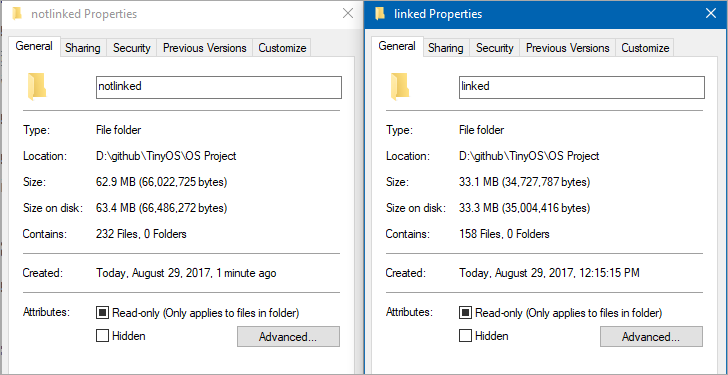The .NET team has built a linker to reduce the size of .NET Core applications. It is built on top of the excellent and battle-tested mono linker. The Xamarin tools also use this linker so it makes sense to try it out and perhaps use it everywhere!
"In trivial cases, the linker can reduce the size of applications by 50%. The size wins may be more favorable or more moderate for larger applications. The linker removes code in your application and dependent libraries that are not reached by any code paths. It is effectively an application-specific dead code analysis." - Using the .NET IL Linker
I recently updated a 15 year old .NET 1.1 application to cross-platform .NET Core 2.0 so I thought I'd try this experimental linker on it and see the results.
The linker is a tool one can use to only ship the minimal possible IL code and metadata that a set of programs might require to run as opposed to the full libraries. It is used by the various Xamarin products to extract only the bits of code that are needed to run an application on Android, iOS and other platforms.
I'll add this line to a nuget.config in my project's folder. Note that NuGet will inherit global settings and ADD this line.
<?xml version="1.0" encoding="utf-8"?>
<configuration>
<packageSources>
<add key="dotnet-core" value="https://dotnet.myget.org/F/dotnet-core/api/v3/index.json" />
</packageSources>
</configuration>
Then I'll add the IL Linker's NuGet package to my project with this command line command (or from Visual Studio):
dotnet add package ILLink.Tasks -v 0.1.4-preview-906439
The assemblies will automatically be "trimmed" when they are published (not built) so I'll build it twice, disabling it with a switch:
D:\github\TinyOS\OS Project>dotnet publish -c release -r win-x64 -o notlinked /p:LinkDuringPublish=false
Microsoft (R) Build Engine version 15.3 for .NET Core
TinyOSCore -> D:\github\TinyOS\OS Project\bin\Release\netcoreapp2.0\win-x64\TinyOSCore.dll
TinyOSCore -> D:\github\TinyOS\OS Project\notlinked\
D:\github\TinyOS\OS Project>dotnet publish -c release -r win-x64 -o linked
Microsoft (R) Build Engine version 15.3 for .NET Core
TinyOSCore -> D:\github\TinyOS\OS Project\bin\Release\netcoreapp2.0\win-x64\TinyOSCore.dll
TinyOSCore -> D:\github\TinyOS\OS Project\linked\
And here's the results:

You can also run it with /p:ShowLinkerSizeComparison=true and get a nice table. I've trimmed the table as it's super long.
TinyOSCore -> D:\github\TinyOS\OS Project\bin\Release\netcoreapp2.0\win-x64\TinyOSCore.dll
Before linking (B) After linking (B) Size decrease
----------- ----------- ----------- -----------
Total size of assemblies 48,025,824 16,740,056 65.14%
----------- ----------- ----------- -----------
TinyOSCore.dll 36,352 36,352 0.00%
Microsoft.Extensions.Configuration.dll 24,584 24,584 0.00%
Microsoft.Extensions.Configuration.Abstractions.dll 20,480 20,480 0.00%
Microsoft.Extensions.Configuration.Binder.dll 24,064 24,064 0.00%
Microsoft.Extensions.Configuration.FileExtensions.dll 22,528 22,528 0.00%
Microsoft.Extensions.Configuration.Json.dll 24,072 24,072 0.00%
Microsoft.Extensions.DependencyInjection.dll 46,600 46,600 0.00%
Microsoft.Extensions.DependencyInjection.Abstractions.dll 35,336 35,336 0.00%
Microsoft.Extensions.FileProviders.Abstractions.dll 17,920 17,920 0.00%
Microsoft.Extensions.FileProviders.Physical.dll 31,240 31,240 0.00%
Microsoft.Extensions.FileSystemGlobbing.dll 39,432 39,432 0.00%
Microsoft.Extensions.Options.dll 26,120 26,120 0.00%
Microsoft.Extensions.Options.ConfigurationExtensions.dll 16,904 16,904 0.00%
Microsoft.Extensions.Primitives.dll 33,800 33,800 0.00%
Newtonsoft.Json.dll 639,488 639,488 0.00%
Microsoft.CSharp.dll 1,092,096 392,192 64.09%
Microsoft.VisualBasic.dll 465,416 0 100.00%
Microsoft.Win32.Primitives.dll 18,968 4,608 75.71%
Microsoft.Win32.Registry.dll 85,008 0 100.00%
SOS.NETCore.dll 54,264 0 100.00%
System.AppContext.dll 14,336 2,560 82.14%
System.Buffers.dll 14,336 2,560 82.14%
System.Collections.Concurrent.dll 206,360 31,744 84.62%
System.Collections.Immutable.dll 2,378,264 0 100.00%
System.Collections.NonGeneric.dll 96,792 24,576 74.61%
System.Collections.Specialized.dll 88,608 15,360 82.67%
System.Collections.dll 326,664 52,224 84.01%
TinyOSCore -> D:\github\TinyOS\OS Project\bin\Release\netcoreapp2.0\win-x64\publish\
You can see in some places where there's no size decrease. That's because I'm using those assemblies completely. Some see a 100% decrease - they've been removed entirely - because I'm not using the Registry, for example. And some see a fractional decrease because I'm using some methods but not others.
You can check out the full instructions and try this yourself at https://github.com/dotnet/core/blob/master/samples/linker-instructions.md. Again, it's a work in progress.
Sponsor: Check out JetBrains Rider: a new cross-platform .NET IDE. Edit, refactor, test and debug ASP.NET, .NET Framework, .NET Core, Xamarin or Unity applications. Learn more and download a 30-day trial!
© 2017 Scott Hanselman. All rights reserved.
from Scott Hanselman's Blog http://feeds.hanselman.com/~/452296766/0/scotthanselman~Experimental-Reducing-the-size-of-NET-Core-applications-with-Monos-Linker.aspx
Comments
Post a Comment